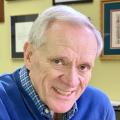Bleary-eyed after 18 hours of flying from Santa Fe, N.M., to Madrid, my day was illumined by the smile and unexpected exclamation of the Marriott hotel desk clerk. “I’ve done the Camino,” Uxoa declared. “It was the best experience of my life.” I’m here to follow her footsteps, and those of hundreds of thousands more, over hundreds of years, on the pilgrimage to Santiago de Compostela.
Countless times I’ve heard testimonies like Uxoa’s, and I wonder why. Since I first heard my wife’s cousin relate his life-changing experience on the Camino almost seven years ago, something has beckoned me. And I’m not alone: 200,000 pilgrims will walk these well-trodden paths this year. Although they come from all corners of the globe, many are Europeans. But you’re unlikely to find many of them walking into any of Europe’s churches. From my hotel I went to a nearby Catholic church on Sunday morning. The faithful were mostly older and gray-haired, not unlike congregations at home.
Pew Research just released results of a major survey on why Americans go, and don’t go, to church today. Not surprisingly, the number of those attending religious services regularly is declining, with numbers of younger people the highest. But among these, there is a surprise: Of those who cite a reason other than lack of belief for not attending, 70 percent say that religion is important in their lives. When asked why they do not regularly attend religious services, the most frequently cited reason is this: “I practice my faith in other ways.”
That’s what intrigues me about the Camino. Isn’t it evidence of a spiritual thirst not being satisfied by institutional religion? And if so, what might this mean for the future of faith?
Perhaps it was not that much difference in past centuries. The Camino de Santiago — the Way of St. James — was established about 1,200 years ago. Christian legends place the Apostle James evangelizing in Spain before returning to Judea, where he was beheaded. But his bones miraculously ended up in Galicia, in northern Spain. Pilgrimages to his relics in Santiago de Compostela began, and eventually this city rivaled Rome and Jerusalem as the most important Christian destination. Many made this journey from France, and others from throughout Europe. It would take nine months to a year, and tens of thousands followed the Way in the Middle Ages.
Relics connected one spiritually to the “living faith of the dead,” and the pilgrimage was a journey into “thin spaces” of spiritual, emotional, and physical experiences. The pathways that followed were not only practical, but also mystical. Pilgrims left the ordinary behind, seeking more, and seeking God.
It seems the same today. The most popular guidebook for the Camino de Santiago is by John Brierley. It divides the entire route into suggested daily treks, and for each one he provides “The Practical Path” with descriptions the terrain, and “The Mystical Path,” with suggestions for the soul. The motives of today’s pilgrims vary widely, sometimes unknown even to oneself. But many are “practicing faith in other ways.”
In my recent book Future Faith: Ten Challenges Reshaping Christianity in the 21 st Century, I explore the trend of “belonging before believing.” The example is how you herd cattle in Australia: Either you build a fence all around the circumference, or else, you dig a well. The organized church is good at building fences. We may not like Donald Trump’s wall, but we erect our own. But modern pilgrims today don’t want to be fenced in. They reject the self-righteous judgments and tightly controlled systems of religious belief determining who is in and who is out. But they are drawn toward wells of living water.
Uxoa, the clerk at my downtown Madrid hotel who is also a pilgrim, had more to say. “I did the Camino alone, without others, and would again. Not even with my boyfriend.” Others say the same. I’ll be joining three others, making our way together. Yet, for each, the Way is a solitary path, going inward while moving forward.
After preparing by walking miles each day for a month, and nearly buying stock in REI, I announced that I was ready. But Kyle Small, whom I’ll be meeting after he has already been on the Way from France for 20 days, sent back a message of wisdom. “No one is ready for the Camino, but the Camino is ready for you.” That’s why it’s called a pilgrimage, and certainly another way of practicing faith.
Got something to say about what you're reading? We value your feedback!







